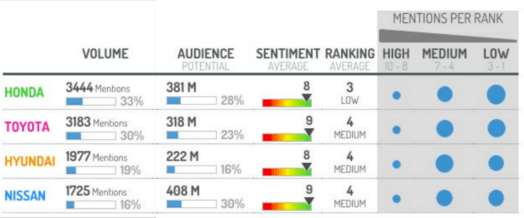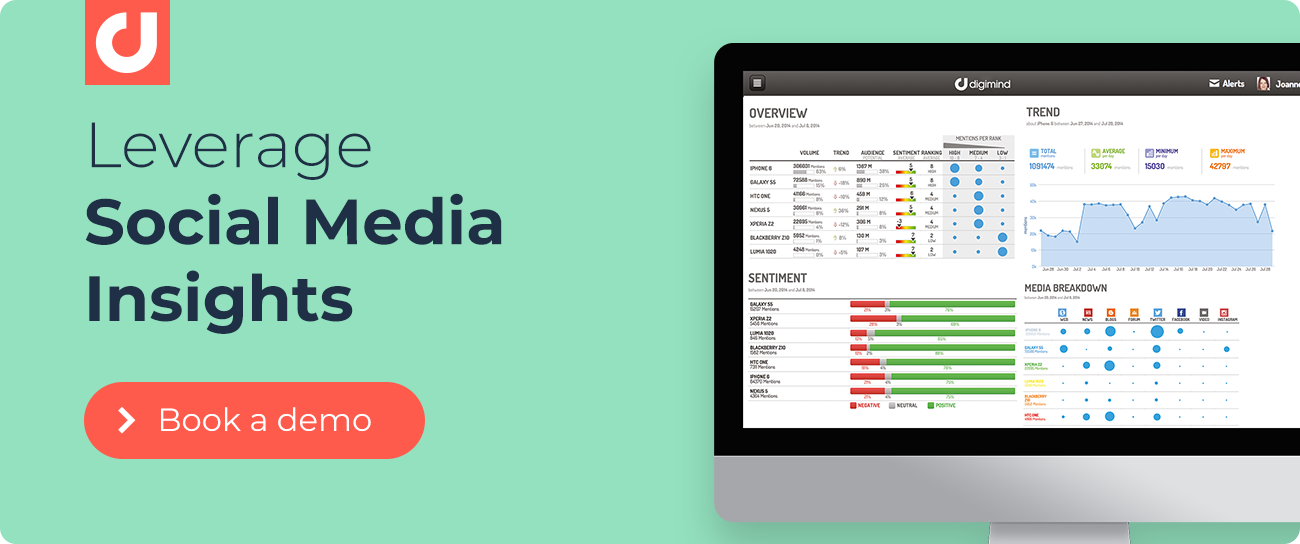8 Good Practices for Competitor Benchmarking on Social Media
Through speaking with digital transformation managers, I realize that upcoming future changes and developments are becoming more integrated, focusing on people, tools, organization and processes, some of which are coming from core marketing books. This is the foundation of this benchmarking approach. The goal of benchmarking is to continuously evaluate your products, services or brand's performance, your organization in comparison with your competitors and leaders' in order to improve them. This is a process you have to continually set up, beyond a one-off competitive study. The objective: position your company to then improve in accordance to referential data you will collect.
 Benchmark: select the best competitors, measure their performances to improve yours
Benchmark: select the best competitors, measure their performances to improve yours
Social Media Listening widely enriches the benchmarking approach as it is an excellent way of permanently collecting information to update your data about competitors and leaders in the field, especially so that you can compare and improve. Through this you'll be able to position your company better in comparison with your competitors, setting off the improvement process with 3 main kinds of data:
- Field and competitive intelligence data published online and on social media by the media and online users: acquisition, strategic alliances, new countries, new targets, new products, hiring, finance, R&D, trade, production...
- Data from client and prospect conversations: product reviews, services, complaints, polls...
- Social Media performance data: these are different indicators that express competitors' social media strategy performance, chosen within the benchmarking framework.
Some good practices are ideal to carry out successful competitor benchmarking on social media.
1. Carry out an audit to define your best competitors
This is about assessing your own strengths and weaknesses, your market position, your own performance, particularly on social media.
With this assessment, you'll be able to determine which competitors (the best ones) to compare yourself to. But it's not only competitors you need to be watching: it's also essential to follow key players and innovating leaders and those stirring up the field that are not your direct competitors. They can be field leaders, or leaders within a field that you want to improve (i.e. marketing automation, customer relationship management, training...), thus you will be able to identify your champion competitors and top leaders. Some advice: limit the benchmark to 6 competitors for a good quality analysis and to avoid accumulating non-usable data due to a lack of time and resources. As benchmarking is continuous, it has to be adjustable and operational.
2. Choose data and indicators to collect on social media
You'll then need to list the types of data you want to collect in order of priority:
- Is it qualitative/quantitive data ?
- Do you want to focus the benchmark around products, innovations, R&D, Human Resources ?
- Do you want to collect Social Media performance data? (conversation Share of Voice on social networks, sentiments towards products and services, presence on social media, community growth).
 Benchmark through social data: a real-time customer insights report
Benchmark through social data: a real-time customer insights report3. Map out your resources
You must identify all necessary sources to carry out effective competitor benchmarking:
• Information produced by your competitors, whether it's deliberate or not.
You perhaps won't have an awareness of the variety of existing sources on the net giving you this valuable information. Therefore, beyond your competitors' corporate site, you must explore and monitor their entire conversation ecosystem:their blog, Twitter accounts, Facebook, LinkedIn, Instagram ... etc. It is also worth checking the social media accounts of your competitors' employees which are used to communicate brand messages and interact with clientele for example. Thus, like one of our clients, you can uncover or deduct when a competitor is going to make contact with a prospect, because of a tweet with an employee. Operationalizing all these social networks concerns more than just those managed by your competitors: you must scan all the conversations (earned media) where users mention the competitors. Measuring your competitors' share of voice is a classic indicator for benchmarking.
• Information generated by external stakeholders.
-Benchmarking competitors also involves identifying all media sources (national press coverage, independent media, financial press coverage, specialised press coverage) which promotes your competitors. Also remember to scan the local press, interesting for constructing or opening of a factory for example.
It must also list and identify market influencers and ambassadors that will voice your competitors, but potentially on new entrants too.
– Institutes, specialized market research firms websites are also a valuable resource.
Often, if the studies are paid, the "executive summaries" already freely provide the details. Audit and consulting firms regularly post on social networks to promote their studies and data on leading sectors of excellence or business practices.
– Think about shared documents on the web: presentations made on Scribd or SlideShare may contain valuable information.
– Try a similar approach for innovation and R&D, consider exploring the basics, patents, but also ideas coming from sharing portals and student thesis' or dissertations.
– Social Performance Data (Owned Media): analyze the performance of your competitors' company accounts: it is to collect all the indicators that make up your competitors or leaders performance on their social accounts, from Twitter to Facebook, LinkedIn, Insgtagram or YouTube. It allows you to see the development of their fans, interaction rates, number of monthly publications, publications generating the most engagement.
4. Ramp up your keyword monitoring
In order to collect the maximum amount of data on your competitors and leaders, you should be thinking "large" in terms of monitoring.
Beyond the classic competitor names, their products and brands (Coca-Cola, Coca-Cola Zero, Coke, Cherry Coke), remember to also monitor their corporate social accounts, products and advertising such as @cocacola and then monitoring their hashtags from campaigns (eg #Tastethefeeling, #ShareaCoke).
We will see in a future post the selection criteria for analysis, as well as the essential data for quality benchmarking.

Written by Jerome Maisch
Marketing Manager @digimindci. Passionate about big data & social marketing. Photography, music and hiking lover
.png?width=100&name=logo%20(1).png)



